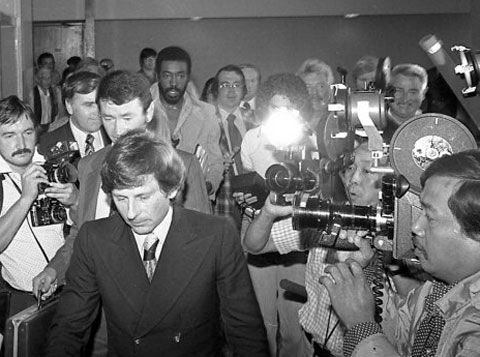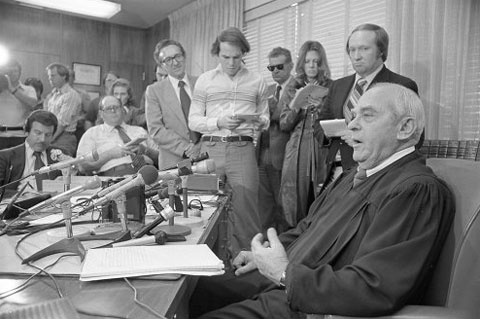Roman Polanski: Wanted and Desired: Laying bare the facts of the 1978 case
By Hiram Lee
5 October 2009
With the recent arrest of film director Roman Polanski in Switzerland at the behest of American authorities and his possible extradition to the US where he could face a lengthy prison term, the director’s life and the legal circumstances in 1978 from which he felt compelled to flee have once again grabbed the attention of the media. The latter appear overjoyed in particular to have one of their long-lost whipping boys returned to them.
In light of these new developments, it is worth revisiting a 2008 documentary that explored the 1978 events and the media frenzy surrounding them. Roman Polanski: Wanted and Desired, directed by Marina Zenovich, is a serious and sensitive examination of the case and argues convincingly that it was carried out illegally, with substantial abuses committed by the presiding judge, Laurence J. Rittenband.
 A scene from Wanted and Desired: Polanski and press during the hearings in 1977
A scene from Wanted and Desired: Polanski and press during the hearings in 1977Roman Polanski was arrested March 11, 1977, in Los Angeles. The director was initially charged with furnishing a controlled substance to a minor, committing a lewd or lascivious act on a child, unlawful sexual intercourse, rape by use of drugs, perversion and sodomy. The victim was Samantha Geimer (then Samantha Gailey), a 13-year-old model Polanski was photographing during a shoot for Vogue magazine. The charges were eventually reduced, and Polanski would plead guilty to unlawful sexual intercourse as part of a plea agreement.
Renowned as the director of such films as Repulsion, Rosemary’s Baby, and Chinatown, Polanski’s arrest for such disturbing crimes triggered a media frenzy. Zenovich’s film shows footage of Polanski repeatedly being swarmed by photographers and journalists, often crushed against walls unable to move.
Geimer was also exposed to the frenzy of the media. Her name was uncovered by the international press, details of the crimes exposed, her life subjected to rumor and accusations of promiscuity and drug use. She was deeply traumatized by it all.
It is a credit to the film and the very humane qualities it displays and promotes, that Zenovich examines the trauma suffered by Geimer, but also ultimately by Polanski himself, at the hands of the media, as well as the criminal behavior of the judge presiding over their case. It is a healthy approach very much at odds with that currently taken by the media, who have begun to vilify Polanski once again and publish the details of the crime, which so disturbed Geimer upon their first release in 1977-1978. One genuinely feels for both her and Polanski by the film’s end.
The scandal of Polanski’s arrest in 1977 marked the second time the director had experienced the unscrupulousness of the American media within the space of a decade. In 1969, the director’s pregnant wife, actress Sharon Tate, and friends gathered at her home were murdered by members of the Charles Manson “family.” Polanski’s life became subject to salacious speculation after the murders. Here was the director of quasi-horror films like Repulsion, or Rosemary’s Baby, in which a pregnant woman was victimized by a satanic cult. He must be somehow to blame, if not directly culpable in the killings.
In an interview, producer Daniel Melnick describes Polanski as “the perfect villain for them” (the US media): “He was a foreigner. He had a thick accent. He made lots of money in the movie business. He was short, he was perfect.”
Among the more memorable footage in the film is of Polanski speaking through tears at a press conference, chastising reporters in a quietly angry voice not long after the Manson-inspired killings had taken place. The director, who had survived the Holocaust as a boy but had lost his mother to the camps, and already seen so much tragedy and violence in his life, speaks very softly and with some effort explaining that his time with Sharon Tate had “been the only true period of happiness” in his life.
The bulk of the film is spent detailing the events of Polanski’s 1977 arrest and the court proceedings that followed, which were characterized by a media circus atmosphere and judicial abuse.
Zenovich was able to include both Roger Gunson, the prosecutor in the 1978 case, described as “a very straight-thinking Mormon,” and Douglas Dalton, Polanski’s defense attorney in the film. Dalton had avoided speaking publicly about the case until now. He chose to cooperate with the filmmakers, he says, because he wanted to assure they present a factual telling of the story. Both Gunson and Dalton are very forthcoming.
The presiding judge, Laurence J. Rittenband, died in 1993. Described as a “tough judge and a tough sentencer,” Rittenband also courted the spotlight and had presided over cases involving other celebrities, including Marlon Brando, Cary Grant, and Elvis Presley. Both Gunson and Dalton have come to agree, and in fact, agreed in 1978, that Rittenband had behaved not only improperly but illegally in his handling of the Polanski case.
While initially intending to go to trial, Dalton and Polanski eventually chose to plead guilty to a single count of unlawful sexual intercourse, as part of an agreement with Gunson. As a result, Polanski was evaluated by psychiatrists who found that he was not a “Mentally Disordered Sex Offender.” They recommended a sentence of probation.
The media-conscious Rittenband, disquieted at the prospect of handing Polanski a light sentence when the US media and all the forces of “law and order” were calling for the director’s head, refused to accept the recommended sentence of probation.
The judge wanted to put Polanski in prison, but knew that any sentence would immediately be appealed by his attorneys. In a highly improper ruling, Rittenband chose to sentence Polanski to 90 days in Chino State Prison for a diagnostic assessment consisting of an evaluation of Polanski’s mental state by still more doctors. Because the 90-day detention was mandatory and could not legally be appealed, it was the only way to insure Polanski would spend time behind bars. The ruling was opposed by both Dalton and Gunson who argued that it was illegal to use the diagnostic detention as punishment for a crime.
 A scene from Wanted and Desired: Judge Rittenband and the media in his chambers, February, 1978
A scene from Wanted and Desired: Judge Rittenband and the media in his chambers, February, 1978This attempt by the judge to circumvent Polanski’s legal right to appeal was followed by an increasingly bizarre series of incidents. With the judge insistent upon ordering the 90-day detention at Chino, Dalton and Gunson met with Rittenband in his chambers. Dalton sought a stay of one year before the judge ordered the Chino detention so that Polanski could complete his latest film, a work Polanski had no real interest in, but one that was necessary in order to pay his legal bills. The judge refused, but agreed to order a series of 90-day stays that he promised to approve for up to one year. As the film points out, the judge thought “90 days” would “sound better” to the press.
In an extraordinary turn of events, the judge instructed both Gunson and Dalton to take part in a charade in which they would proceed in court as though no deal had been reached in the judge’s chambers. With the first stay of 90 days already guaranteed by the judge, Rittenband informed Gunson that he was to argue before the court that Polanski should be imprisoned while Dalton was to argue for probation. The judge would pretend to arrive at a decision that he had already made. The whole affair was a performance concocted for the benefit of the news media, so that Judge Rittenband could save face.
The charade was carried out and, granted his stay, Polanski flew to Europe, as was his right, to finish work on his film. During a break in filming in Germany, Polanski attended an Oktoberfest celebration with friends. He was photographed at the event seated between two women. The photo was published in newspapers and tabloids.
The media seized upon the photo to further vilify Polanski. Judge Rittenband was incensed and embarrassed, and came under pressure from those who said the film director was flaunting his freedom and making a mockery of his trial.
Rittenband ordered Polanski back to the US and into Chino State Prison for the diagnostic. When, to his further embarrassment, Polanski was released early and once again found not to be a Mentally Disordered Sex Offender, the judge had had enough. With probation once again recommended as a sentence, Rittenband began to hint that, while Polanski might think he was only getting a slap on the wrist, the judge fully intended to throw the book at him.
The judge also asked that Polanski waive his right to any future deportation hearing in which the director could challenge any attempt by US authorities to expel him from the country. Rittenband had no jurisdiction in matters of deportation and his attempt to deprive Polanski of his right to a deportation hearing was yet another example of misconduct.
Under these conditions Polanski felt compelled to flee the country. He had complied with all the orders of the court until the judge’s actions became so egregious that he could no longer afford to do so.
Far from the monster he had been made out to be, Polanski continued to direct films in Europe and would eventually remarry and raise a family. He won an Academy Award in 2003 for his direction the previous year of the remarkable The Pianist.
Zenovich has done a fine job in laying bare the facts of Polanski’s case. The documentary helps make clear that the rearrest of Polanski in Switzerland is not a case of justice being served.





Follow the WSWS